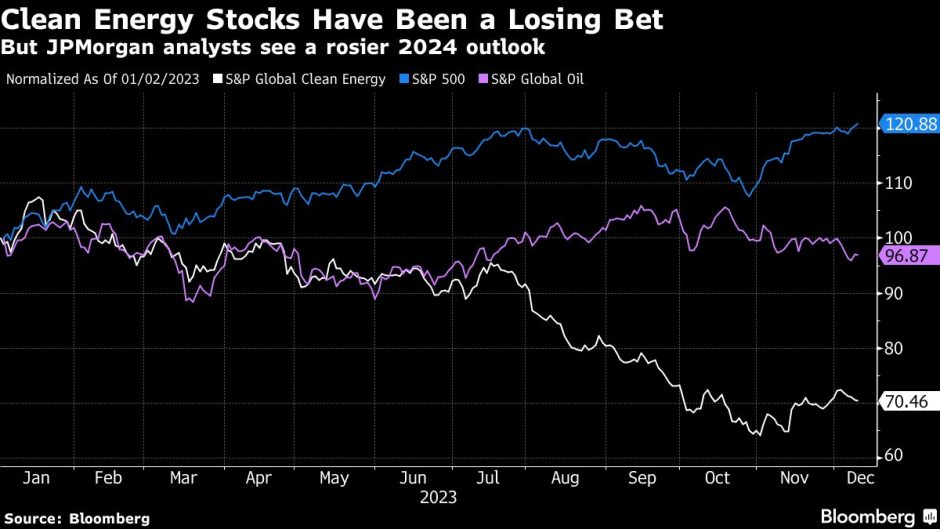
The world’s biggest ESG fund class, which sits on roughly $5 trillion of client assets, has raised its exposure to the oil and gas sector by about two-thirds since stricter regulations were enforced 2 1/2 years ago.
Funds that are registered as “promoting” environmental, social and good governance metrics had about 2.3% of their holdings in fossil fuel assets at the end of the third quarter, up from 1.4% right after Europe introduced a framework for ESG investing in early 2021, according to data provided by Morningstar Inc. Exposure to renewable energy assets slipped to 0.3% of total holdings from 0.4% in the same period, the data show.
The development, which reflects changes in asset valuations as well as outright purchases, follows a spike in oil prices triggered by the Ukraine war and a “terrible year” for renewables, Hortense Bioy, global director of sustainability research at Morningstar, said in an emailed response to questions.
It also coincides with growing calls from the heavyweights of global finance to bring fossil fuels into the ESG machine room. Nowhere was this in plainer view than at the COP28 climate summit in Dubai, which was presided over by the head of the Abu Dhabi National Oil Co. On Wednesday, talks ended in a deal calling for a global transition away from fossil fuels.
Climate activists had hoped for language that would target a phase-out of fossil fuels. Instead, the final wording of the COP28 agreement “leaves loopholes allowing fossil fuel producers and states to continue with business as usual,” according to Amnesty International.
The deal calls for a global tripling of renewable energy capacity by 2030. But it also paves the way for lower-carbon fuels like natural gas to play a role in the shift to cleaner energy sources.
ESG fund managers may soon get a more explicit go-ahead from regulators to hold fossil fuels. In Europe, where ESG investing rules are the world’s most far-reaching in scope, authorities are in the process of reviewing the framework they enforced in early 2021, and how to treat so-called brown assets will be a key focus.
The Sustainable Finance Disclosure Regulation, which steers about $11 trillion in total investment holdings, may be rewritten to encourage funds to hold so-called transition assets, namely those that are currently brown but have the potential to become greener.
What Is SFDR?
The world’s biggest ESG investing rulebook was enforced in March 2021 with a view to fighting greenwashing and promoting a sustainable allocation of capital. It comprises two disclosure categories of ESG funds: Article 8 funds are supposed to “promote” environmental, social and good governance goals, while Article 9 funds are supposed to make ESG their outright “objective.” According to Morningstar data, which excludes money market funds, funds of funds and feeder funds, Article 8 sits on roughly $5 trillion worth of client assets.
Mairead McGuinness, EU commissioner for financial services and markets, said last month that the bloc may give asset managers more freedom to include companies with high-carbon footprints in ESG portfolios, provided there’s a credible plan for cutting their emissions.
“We need that companies also have an opportunity to transition, and maybe that’s what we need to focus a bit more on,” McGuinness said last month during a Bloomberg Television interview. “Because we talk too much in green or brown, good and bad. Actually, those companies that aren’t there yet are the ones we need to put the money into so they become more sustainable.”
To help investors identify which funds are actually aiding the transition, the EU may start requiring them to declare the extent to which they aim to reduce greenhouse gas emissions. That’s as studies indicate transparency remains an issue.
As an industry, asset managers had the lowest score in a recent EY global assessment of climate-risk disclosures. Transparency is lacking even though many firms have set net zero targets that will require “a significant rebalancing of portfolios,” Matt Bell, head of climate change services at EY, told Bloomberg.
Some national regulators in the EU are adopting a much tougher stance. In France, the financial watchdog recently stipulated that asset managers will only be allowed to use its national ESG fund label if they exclude fossil fuel companies that are still expanding production. The plan has the potential to force about $7.6 billion worth of oil and gas divestments, Morningstar estimates.
Meanwhile, the EU’s toughest ESG fund designation has been reducing its exposure to fossil fuels over the past 2 1/2 years. Oil and gas assets in Article 9 funds fell to 0.1% of the total last quarter from 0.6% in early 2021, the Morningstar data show. Investments in renewables rose slightly to 1.8% from 1.7%.
From a returns perspective, however, sticking with renewables has been difficult in 2023. The S&P Global Clean Energy Index is down roughly 30%, while the S&P 500 is up 20%. The S&P Global Oil Index has slipped about 3% in the same period.

Clean Energy Stocks Have Been a Losing Bet But JPMorgan analysts see a rosier 2024 outlook.Capital-intensive renewables companies have had to contend with “rising financing costs, materials inflation and supply chain disruption,” Bioy said.
Those headwinds may soon recede, though, according to analysts at JPMorgan Chase & Co. They suggest that 2024 may present a “highly favorable” backdrop for traditional ESG assets that struggled in a high interest-rate environment.
Next year also will be “pivotal” for ESG regulations, the JPMorgan analysts said in a note published this month.